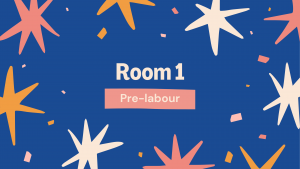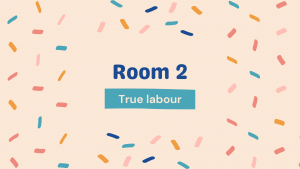Our interpretation of Natalie Meddings’ “Room 1, Room 2” description of labour
Natalie Meddings is the author of ‘How to Have a Baby’ and ‘Why Home Birth Matters’ and during lockdowns created a series of videos with Jenna Rutherford on YouTube. The series was called ‘How to have a baby in a hospital during the coronavirus’ and was a reaction to many of the homebirth services and birth centres being closed during that time. We have shared the links to this video series so many times and lots of women have found them incredibly helpful so thank you to Natalie and Jenna for creating this content!
The main aims of these videos, we think, was to explain how to recognise these different rooms so that women can use this to decide if and when to transfer into hospital. As they quite rightly said, hospitals are not set up to accommodate women who are in room 1, so in order to be as undisturbed as possible when planning a hospital birth, wait until you are in room 2 to transfer in. We would argue that hospitals are not set up for women to give birth in at all because they do not meet any of the basic needs, but if you are choosing a hospital birth it’s important to consider these factors when deciding when to go. You can also use this description to decide if/when to call a midwife to your homebirth – many women choose to call the midwife “at the last minute” to avoid unnecessary interruption and intervention. It’s worth remembering that you don’t have to call a midwife at all if you don’t want. We believe that this description is incredibly useful for all women because it can really help with the mindset of labour, whether you’re in hospital, at home with a midwife or freebirthing. We decided to try to condense what Natalie and Jenna talked about in their informative videos into a short written summary in the hope that it will be helpful to women and their birth partners.
We often hear about labour lasting days or even weeks, and this is often something that women worry about – particularly first time mums. Understanding the distinction between what pre-labour feels like in comparison to true labour can be the difference between your labour feeling like days/weeks long and it only feeling like a few hours. The essence of this description is based on what it feels like from the woman’s perspective, not what it looks like from the outside or what can be measured, which is often what is used by the maternity system as a gauge of “early labour” and “active labour”. The only true measurement of which room a woman is in is based on how she feels, so there is no place for timing contractions or measuring the dilation of her cervix. The early signs that something is starting to happen (you’re entering into room 1) can often come with a sense of expectation, anticipation and sometimes fear and tension. Recognising that you are in room 1 can alleviate that sense of expectation and thus release the tension, which is using up a lot of your energy! I believe this is often why women who are having their second or subsequent baby tend to describe having shorter labours, because they are not giving much (if any) focus to room 1 either because there is a familiarity there or simply because they have other children that need their attention. The key here is giving room 1 as little attention as possible.
In our interpretation we have included what these rooms might look like from the outside for the benefit of birth partners/doulas so that you too can recognise which room a woman is in and how to best support her where she is at.

Room 1
Room 1 is pre-labour. This is the part that is most unpredictable in length and can vary quite a lot from woman to woman. The length of pre-labour can depend on lots of different factors including how emotionally ready you are for birth and parenthood, and who you are as a person. During pre-labour, your body is preparing for labour. Your baby is moving into a good position, possibly rotating and descending slightly. The cervix at this point is still firm and closed, but everything the body is doing at this point is working on softening the cervix and positioning the baby to help with that. It does all of this on its own and needs none of your attention or energy. The idea of labelling this part “pre-labour” is not to diminish the intensity of what come up during this time, we know that this time is often when the emotional stuff comes up along with sometimes very intense physical sensations and these are by no means irrelevant, but rather to lessen that sense of expectation and pressure.
What it might feel like:
- Cramps, sensations or even surges can come and go
- They can feel strong
- They can feel regular and intense
- You might feel the need to sway or moan or breath in a certain way
- Things might start and then stop again – this is okay! If you find yourself feeling frustrated by the slowing down or stopping, a mental reset might be needed because it is likely that you’re feeling pressure to keep things going (either from yourself or someone external) and that is only going to exhaust you
- The biggest identifier of room 1 is that between surges, no matter how regular or intense they feel, you are coming back out of it and continuing as normal
- Between surges you can talk normally, ask for things, walk about and do your normal stuff
- Waters can break before or during room 1 or room 2 or not at all, so try to get rid of any expectations that this is an indicator of whether you’re in labour or not
What it might look like from the outside:
- She may be making noises through her surges and perhaps moving in a certain way that feels good
- She will come out of that once the sensations pass and will be able to engage in conversation and/or normal activities like eating and drinking
- She is consciously making decisions about where she wants to be with her thinking brain
- She may want distractions – this is a good thing in room 1 because her body does not need her attention, in fact the less attention she can pay it the better

What is the reset button and how do I hit it?
A reset might be needed when you recognise that you are still in room 1 but your expectations have taken over and you are putting too much of your energy into what your body is doing. Sometimes this looks like being in a dark room for hours on end listening to your birth playlist, but feeling disappointed that “nothing is happening”. So hitting the reset button could simply be opening the curtains and changing your clothes, or having a shower and getting some fresh air. It could also be just sitting on the sofa and watching a movie, but the point is that it is something that feels normal to you. Something that relieves you of all the expectation and tension that has built up from having sensations. If you have called your partner home from work or asked your doula or birth partner to come over, it’s okay to rethink this and send them away again if they are adding to the sense of expectation. What would you be doing if you were just on your period? You don’t need to be doing anything to “encourage” or “establish” labour, because it will be a futile use of your energy.
There is no downside to hitting the reset button because if your body is ready to go into room 2 and you’ve just got dressed, your body will soon let you know that she would prefer to be naked. You’re not going to delay or miss going into room 2 because it is inevitable and uncontrollable, so when your body is ready for it to happen you’ll know about it – you won’t miss it.
Don’t fear the reset button, it can be a really powerful tool.

Room 2
Room 2 is true labour. This is where it actually begins. At this point there is a shift and your baby is really descending – you can’t miss this sensation. In room 2 you will be reacting to your mammalian brain, not your thinking brain. Pre-labour has moved your baby so that their head is playing its part in pressing on the cervix which signals the release of hormones that cause contractions and the release of endorphins (your natural pain killers) to match the sensations. This is where your baby is moving down through your pelvis and coming earthside – and your body is leading the way.
What it might feel like:
- Surges become predictable and you respond rhythmically, ritually and instinctively
- You no longer have any desire to engage with the outside world during or between your surges
- You might intuitively move to a quieter or darker room in the house to meet your basic needs (feeling safe, warm, unobserved & undisturbed)
- You may prefer to be alone
- All of your focus and energy is turned inward, listening and responding to the sensations in your body
- The noises you make might become deeper and more chesty than they were before
- You will be hyper-aware of any danger – this is instinctual
- You are moving into positions that feel good without thinking about it
- You’ll likely be drawn to being close to the ground
- Your body is taking over, and it feels good
- You may feel a sense of surrender – it is safe to go with this because you have chosen a safe environment and only invited safe people into your space
What it might look like from the outside:
- If she needs something, she will no longer be polite about it (if she uses words at all)
- She may take clothing or sheets off as she feels increasingly hot
- She no longer comes up between contractions, she will likely stay deeply within herself with her eyes closed or her head buried because she is focusing intently on the sensations
- She is also hyper-alert so any disturbance in the room is going to have an impact, it’s really important during this time to not make noise or distract her
- She may appear to be fearful if she is moving through transition, she may say things that sound scary but she is waiting for her own reassurance. You don’t need to say anything, she will find it within herself.
- If she needs something she will let you know either verbally or non-verbally. Be aware of those cues but you don’t need to ask her questions – just have things on hand to pass to her if she indicates that she wants it
We hope that this description helps to relieve some of the expectations women feel about “getting labour going”, “keeping labour going” or “speeding things up” that come from themselves, society, the maternity system and sometimes partners. We would love to hear your experiences of room 1, room 2 and whether or not you used that reset button!
If you’d like to share your experiences or chat about any of them, we’re here to listen.
